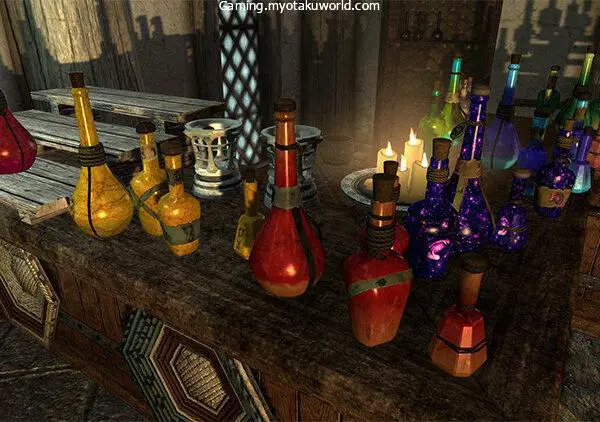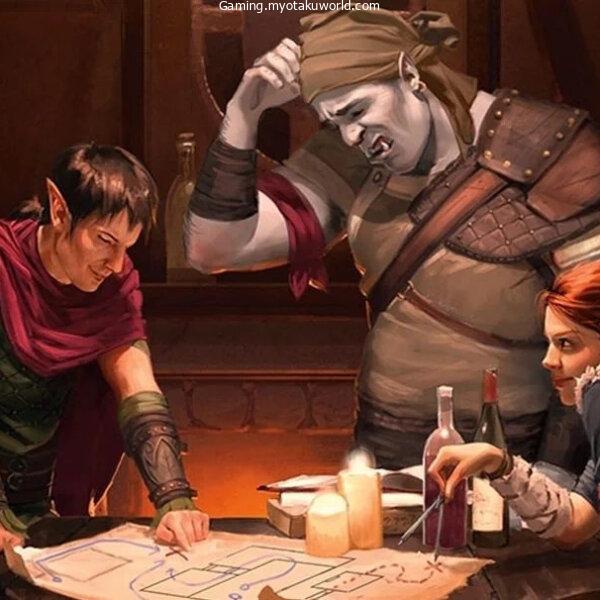The most sinister and ominous magic that is available to spellcasters of Dungeons and Dragons.
Necromancy is easily my preferred school of magic and it has some of the most amazing spells available.
The school of magic provides powerful spells that cause damage, crowd control, and the most significant perk: zombies!
The list is ranked based on my personal views on the spells found in the Necromancy school by taking into account the following factors:
- Cost of casting the spell.
- The maximum damage, or the usability if the target is successful in their saving throw.
I decided to not include spells that contain expensive components (i.e., True Resurrection).
These are excluded due to their cost to cast, and most campaigns will not let you reach this amount of wealth.
It’s important to keep in mind that constitution saving throws are the most common requirement to get maximum damage from these spells.
Constitution is by far the most frequently used stat that you can get an advantage with, which means it’s harder to achieve maximum damage without an amazing roll or a strategic approach.
- 25. Magic Jar
- 24. Speak with Dead
- 23. False Life
- 22. Spare the Dying
- 21. Chill Touch
- 20. Blindness/Deafness
- 19. Toll the Dead
- 18. Harm
- 17. Blight
- 16. Inflict Wounds
- 15. Vampiric Touch
- 14. Eyeblight
- 13. Soul Cage
- 12. Revivify
- 11. Animate Dead
- 10. Bestow Curse
- 9. Raise Dead
- 8. Shadow of Moil
- 7. Clone
- 6. Contagion
- 5. Enervation
- 4. Negative Energy Flood
- 3. Finger of Death
- 2. Circle of Death
- 1. Danse Macabre
25. Magic Jar
Source: (dndbeyond)
Your body falls into a catatonic state as your soul leaves it and enters the container you used for the spell’s material component.
While your soul inhabits the container, you are aware of your surroundings as if you were in the container’s space.
You can’t move or use reactions. The only action you can take is to project your soul up to 100 feet out of the container, either returning to your living body (and ending the spell) or attempting to possess a humanoid’s body.
24. Speak with Dead
Source: (dndbeyond)
You grant the semblance of life and intelligence to a corpse of your choice within range, allowing it to answer the questions you pose.
The corpse must still have a mouth and can’t be undead. The spell fails if the corpse was the target of this spell within the last 10 days.
Until the spell ends, you can ask the corpse up to five questions. The corpse knows only what it knew in life, including the languages it knew.
Answers are usually brief, cryptic, or repetitive, and the corpse is under no compulsion to offer a truthful answer if you are hostile to it or it recognizes you as an enemy.
This spell doesn’t return the creature’s soul to its body, only its animating spirit. Thus, the corpse can’t learn new information, doesn’t comprehend anything that has happened since it died, and can’t speculate about future events.
23. False Life
Source: (dndbeyond)
Bolstering yourself with a necromantic facsimile of life, you gain 1d4 + 4 temporary hit points for the duration.
At Higher Levels. When you cast this spell using a spell slot of 2nd level or higher, you gain 5 additional temporary hit points for each slot level above 1st.
22. Spare the Dying
Source: (dndbeyond)
You touch a living creature that has 0 hit points.
The creature becomes stable. This spell has no effect on undead or constructs.
21. Chill Touch
Source: (dndbeyond)
You create a ghostly, skeletal hand in the space of a creature within range. Make a ranged spell attack against the creature to assail it with the chill of the grave.
On a hit, the target takes 1d8 necrotic damage, and it can’t regain hit points until the start of your next turn. Until then, the hand clings to the target.
If you hit an undead target, it also has disadvantage on attack rolls against you until the end of your next turn.
This spell’s damage increases by 1d8 when you reach 5th level (2d8), 11th level (3d8), and 17th level (4d8).
20. Blindness/Deafness
Source: (Player’s Handbook p.219)
A debuff that is extremely flexible and allows you to blind or deafen a person (or targets) is very effective as a second-stage spell in the early stages of combat, where you’re extremely comfortable.
In later levels, it may become less effective compared to other spells.
However, it’s still an area in your toolbox.
19. Toll the Dead
Source: (Xanthar’s Guide to Everything p.169)
This beauty is the cantrip, and it will do more damage in the event that the target has the hit points. It ranges between 1d8 and 1d12 and scales only as you progress.
It’s not going to break the record but is consistent.
There’s not much to be proud of about this. It does, however, outdo other damage-based cantrips by giving a ranged choice with more damage.
18. Harm
Source: (Player’s Handbook p.249)
With a simple and sweet wording, Harm gets straight to the point by delivering a massive explosion of destruction (14d6) and netting an average of 49 damage in the event of a failed Constitution save and half of that on the chance of a successful one.
Additionally, the victim’s HP is proportional to the damage that they sustain. This helps with enemies that are able to heal.
The drawbacks of the spell are that it’s ineffective to destroy targets (it cannot lower them below one hitpoint) and it needs an ability to save in order to reach its maximum power.
17. Blight
Source: (Player’s Handbook p.219)
A handy damage spell for enemies who don’t do well with Constitution Saves. Blight provides a fair amount of damage for a fourth-level spell, with a power of 8d8 and an average damage level of 36.
The damage is only increased by 1d8 for each spell slot that is higher than the 4th level.
The fringe cases of immediate killing of non-magical plant species (or maximum damage and disadvantages for magical plants) aren’t that significant and overall, it’s a very damaging spell.
16. Inflict Wounds
Source: (Player’s Handbook p.253)
It’s the Yin of Cure Wound’s Yang Inflict Wounds does an impressive amount of damage as an initial class ability (3d10 for a first-level spell is quite impressive) however, it doesn’t give any additional bonuses or buffs.
As the game progresses, you’ll find yourself using this spell less often. It’s still a fantastic spell until you’ve got one of the bigger boys.
15. Vampiric Touch
Source: (Player’s Handbook p. 285)
Another renowned spell that is part of the arsenal of a necromancer, Vampiric Touch lets you take the life of the unfortunate person that happens to be within your reach.
The damage it causes isn’t something to be proud of. (3d6 and an additional 6 each level of the spell beyond 3.).
You can also take half the damage back in addition to performing the same action, without the need to use any spell slots (only your focus and actions for the duration of the turn).
The disadvantage is that it requires that you be within melee range, which is extremely dangerous for a spellcaster.
14. Eyeblight
Source: (Player’s Handbook p.238)
Eyeblight is a frightening spell. However, it is very adaptable to keep enemies away with one of three requirements:
Making an enemy unconscious, making them run in terror, and having them take advantage of their Dash action to escape or make sick and weakening them in abilities and attack rolls.
You are only allowed to select one type of affliction for each target. Every turn, you get the chance to scare another creature with your frightening shadow eyes.
13. Soul Cage
Source: (Xanthar’s Guide to Everything p.165)
One of the oddest spells in the spellcaster’s collection, Soul Cage lets you literally get the soul of someone after they pass away.
Then, you are able to use it for a few minutes until you’re bored or you overdo it and release the soul of the victim.
This spell lets you select any of the four options available to the soul:
- Healing 2d8
- If you ask it a question, it has to be answered truthfully.
- Gaining an advantage when you roll
- It can be seen in the same place it was a part of for about 10-minutes at a stretch.
However, once you activate this six times your soul is let go.
It’s a tool that can enable you to conduct some research, get the rolls to stick, or even perform quick healing.
12. Revivify
Source: (Player’s Handbook p.272)
Revivify is one of the few spells that reanimate to have was included in our list. Revivify gives you a speedy recovery on a brand new body at a low cost (Only 30gp of diamonds? I’m hoping he went to Jared).
The spell also doesn’t grant the caster negative effects, which is unlike other resurrection spells.
The drawback is how young our target needs to be. When they’ve not been alive for more than an hour, the spell can’t be cast.
It’s useful in extremely difficult combat situations and can give your companions a once-in-a-lifetime exemption from the whole death thing.
11. Animate Dead
Source: (Player’s Handbook p.212)
The classic, iconic necromancy spell.
It brings families closer, slays your enemies, and gives you some skeletons or zombies based on what your personal preference is. It is possible that they will endure for a lifetime.
What’s not to love?
It’s scalable to higher levels, adding two creatures for each spell that goes beyond the 3rd level.
The drawback to this magic spell is that it requires you to be cast each day for 24 hours or else you lose control over the new friend you have made.
Perhaps that’s the reason you encounter random zombies in the dungeons?
10. Bestow Curse
Source: (Player’s Handbook p.218)
Another extremely versatile debuff Bestow Curse lets you afflict your opponent with one or four curses.
- Ability checks are not able to be performed.
- Attack rolls
- It’s possible to skip it.
- You can also cause additional damage if you strike them.
The drawback of this spell is that it is a task that requires focus. As you go through higher slots, it ends up being a non-issue.
9. Raise Dead
Source: (Player’s Handbook p.270)
The sole reanimation spell that we have on our list is Raise Dead. Raise the Dead provides us with 10 days to live with our corpses.
A fairly inexpensive component (in comparison to more expensive spells that have expensive diamonds) The only person who is targeted suffers any penalties.
8. Shadow of Moil
Source: (Xanthar’s Guide to Everything p.164)
It’s probably one of the cooler-looking spells found in Dungeons and Dragons.
The Shadow of Moil allows you to be enveloped with a dark and smoky flame to be the edgiest necromancer. It can be used for changing dim light into darkness and bright light to dim light, and it also provides protection against damage caused by radiation.
The power behind the spell lies in making you so intense that you inflict 2d8 damage on anyone who hits an attack against you.
It’s not a particularly powerful magic spell. It’s still a free hit should you be in a hurry and are able to maintain your concentration.
7. Clone
Source: (Player’s Handbook p.222)
Death is a choice at a certain point, isn’t it? In this instance, it is indeed true.
Yes, the parts could be expensive, especially with diamonds that weigh 1,000 grams or a vessel weighing 2,000 grams, and a cubic inch of flesh could be difficult to get rid of.
However, you can also avail yourself of an opportunity to get a free revision after a couple of months.
At the point where you can cast spells of the 8th level, this spell isn’t going to be too farfetched. It’s also the closest you’ll ever get to a lich-like creature.
6. Contagion
Source: (Player’s Handbook p.227)
Necromancy’s most versatile spell to control crowds, Contagion, allows you to strike a person with one of six deadly illnesses that each bring their unique, savage taste of pain.
Each attack targets a distinct character of the target and can result in a disadvantage when it comes to saving the ability to check and throw and an additional condition such as blindness or losing damage resistance.
The victim must make a constitution save to end its turn, which ends the spell after three successful attempts or allows the spell to last for the entire seven days when they fail three times.
The disadvantage of this spell is that it is able to be treated as a natural disease because it’s considered a natural ailment.
5. Enervation
Source: (Xanthar’s Guide to Everything p.155)
It’s probably the most similar thing a necromancer can be able to Witch Bolt However, at a higher cost and with a larger number of spell slots.
Plus, it does provide damage regardless of whether they make it to save (just half of the damage). It is also able to heal for half the damage that is dealt.
Witch Bolt still offers more damage (if the spell is cast on 5th, they’ll add 5d12 instead of 4d8, but they require rolling to get hit!)
However, it’s a useful option to have.
4. Negative Energy Flood
Source: (Xanthar’s Guide to Everything p.163)
Perhaps one of my top picks on this list deals with the potential for 5d12 damage (half upon an effective saving) and it gives you a zombie for free in the event that it kills the victim!
This is a fantastic price for 5th-level spells.
But the true difference is this:
Negative Energy Flood does not specify the length of time this zombie will last. It only states that it will pursue the nearest creature it can.
Sure, you can’t control it. But it’s a wide possibility for you to jump into and frighten the DM.
Why not let a single zombie wreak havoc?
3. Finger of Death
Source: (Player’s Handbook p.241)
A truly iconic ability in D&D This powerful spell lets you slash at your foe with seven dice as well as 30 additional damage. This will result in an average of damage per casting (or half the damage if you succeed in a Constitution save).
To top it off, the fact that you have sucked an entire life from a living being by using this magic means you’ll have an ongoing zombie that you can control!
This means there are no recasts of 24 hours or costly components needed. It’s like being Frank Reynolds and just keep blasting until you’ve got an army of zombies.
2. Circle of Death
Source: (Player’s Handbook p.221)
This is the most powerful in the world of Area of Effect damage spells that are part of a necromancer’s toolkit, allowing you to destroy any object within a 60-foot globe for 8d6 necrotic damage.
It’s not as classic as Fireball… that is, if you are familiar with D&D gameplay, made an error with the 5th Edition and WotC acknowledged the error.
However, Circle of Death does offer three times the radius of its fiery counterpart. It also is a bit more powerful with more spell slots that add 2d6 damage, which is more than the Fireball’s 1d6.
1. Danse Macabre
Source: (Xanthar’s Guide to Everything p.153)
My absolute favorite Necromancy spell from 5e. Danse Macabre has to be one of the most powerful spells that are available.
You not only get to reanimate up to five small or medium creatures, either skeletons or zombies, but they also receive bonuses for their attacks and damage, based on the modifier for your spellcasting abilities.
Additionally, there are an additional 2 zombies for every spell slot that goes beyond five levels. You can get a maximum number of 13 zombies (it’s quite spooky!) to wreak havoc over the remainder of the hour.
The downside is that it’s not as fast as a problem is a problem. There is only one hour of undead rooster-killing in your tiny Army of Darkness. Therefore, you must get it done.









